Ryanair's Marketing Strategy: A Report on PRESTCOM, SWOT Analysis
VerifiedAdded on 2023/06/11
|9
|2032
|311
Report
AI Summary
This report provides an analysis of Ryanair's marketing strategies and principles, focusing on product promotion strategies and effective service delivery. It examines Ryanair, a leading low-cost airline in Europe, using the PRESTCOM model to analyze the external environment, competition, organization, and marketing aspects. The report also includes a SWOT analysis to understand the internal environment of the organization, along with marketing frameworks and theories. Recommendations are provided to enhance Ryanair's customer service, offerings for business travelers, and technological innovation to improve overall revenue and performance.
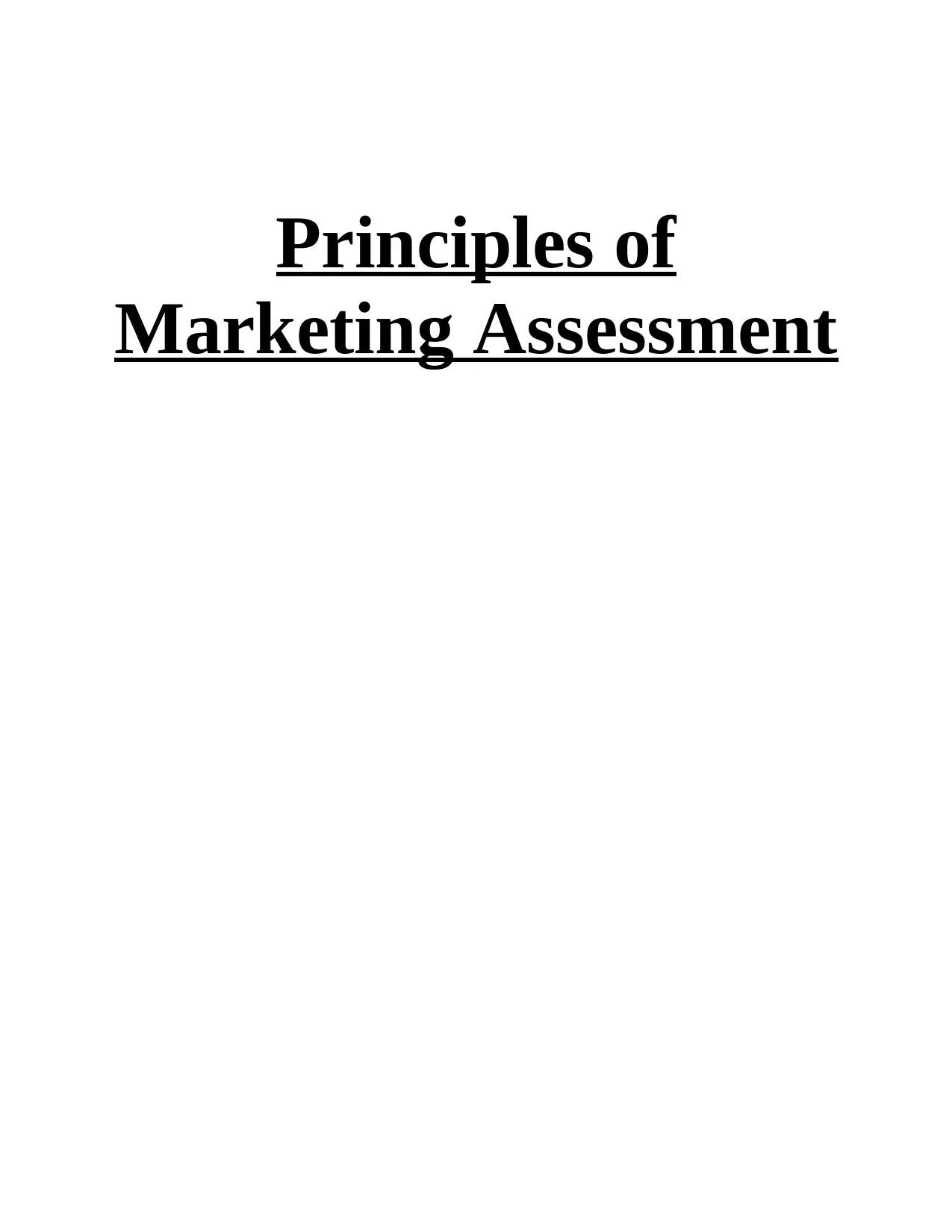
Principles of
Marketing Assessment
Marketing Assessment
Paraphrase This Document
Need a fresh take? Get an instant paraphrase of this document with our AI Paraphraser
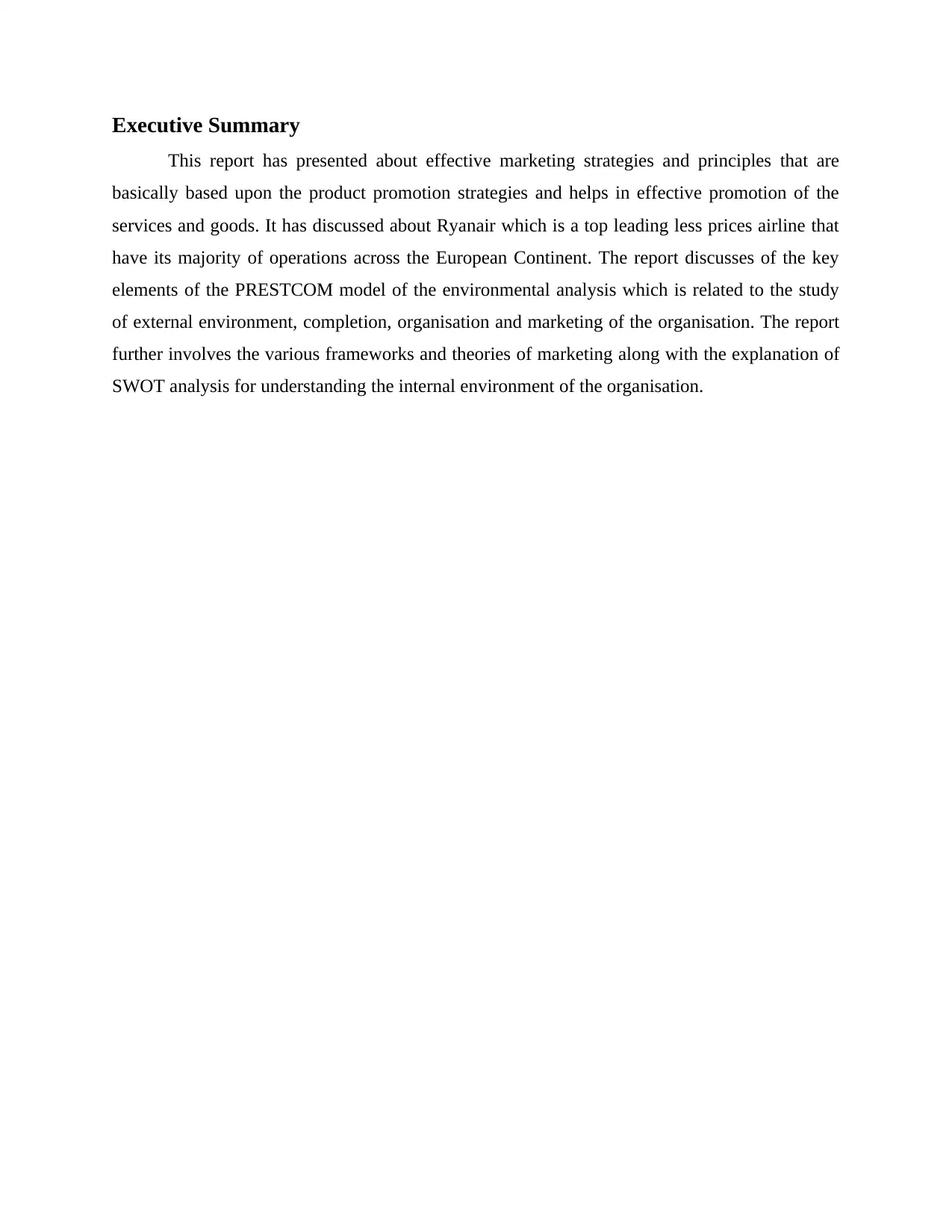
Executive Summary
This report has presented about effective marketing strategies and principles that are
basically based upon the product promotion strategies and helps in effective promotion of the
services and goods. It has discussed about Ryanair which is a top leading less prices airline that
have its majority of operations across the European Continent. The report discusses of the key
elements of the PRESTCOM model of the environmental analysis which is related to the study
of external environment, completion, organisation and marketing of the organisation. The report
further involves the various frameworks and theories of marketing along with the explanation of
SWOT analysis for understanding the internal environment of the organisation.
This report has presented about effective marketing strategies and principles that are
basically based upon the product promotion strategies and helps in effective promotion of the
services and goods. It has discussed about Ryanair which is a top leading less prices airline that
have its majority of operations across the European Continent. The report discusses of the key
elements of the PRESTCOM model of the environmental analysis which is related to the study
of external environment, completion, organisation and marketing of the organisation. The report
further involves the various frameworks and theories of marketing along with the explanation of
SWOT analysis for understanding the internal environment of the organisation.
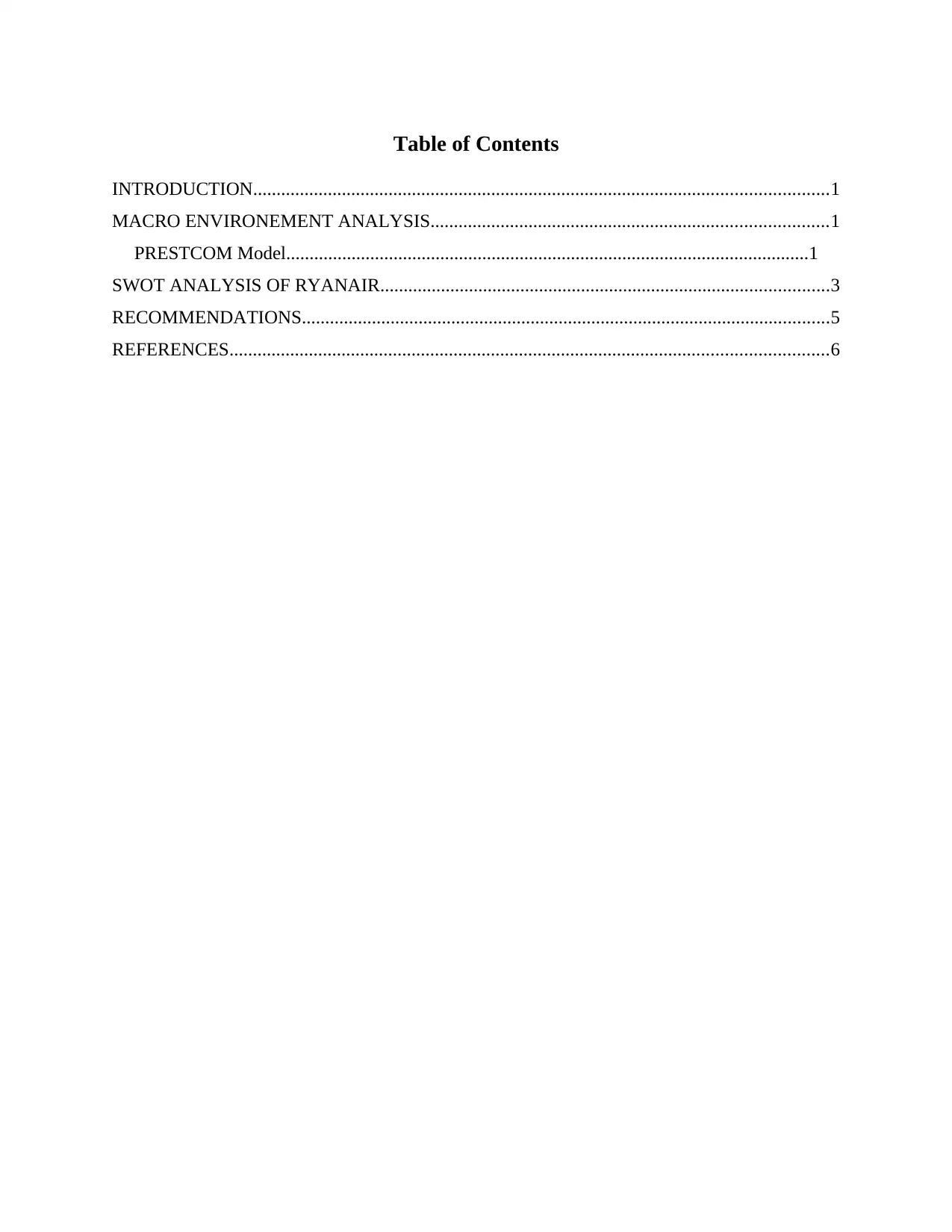
Table of Contents
INTRODUCTION...........................................................................................................................1
MACRO ENVIRONEMENT ANALYSIS.....................................................................................1
PRESTCOM Model................................................................................................................1
SWOT ANALYSIS OF RYANAIR................................................................................................3
RECOMMENDATIONS.................................................................................................................5
REFERENCES................................................................................................................................6
INTRODUCTION...........................................................................................................................1
MACRO ENVIRONEMENT ANALYSIS.....................................................................................1
PRESTCOM Model................................................................................................................1
SWOT ANALYSIS OF RYANAIR................................................................................................3
RECOMMENDATIONS.................................................................................................................5
REFERENCES................................................................................................................................6
You're viewing a preview
Unlock full access by subscribing today!
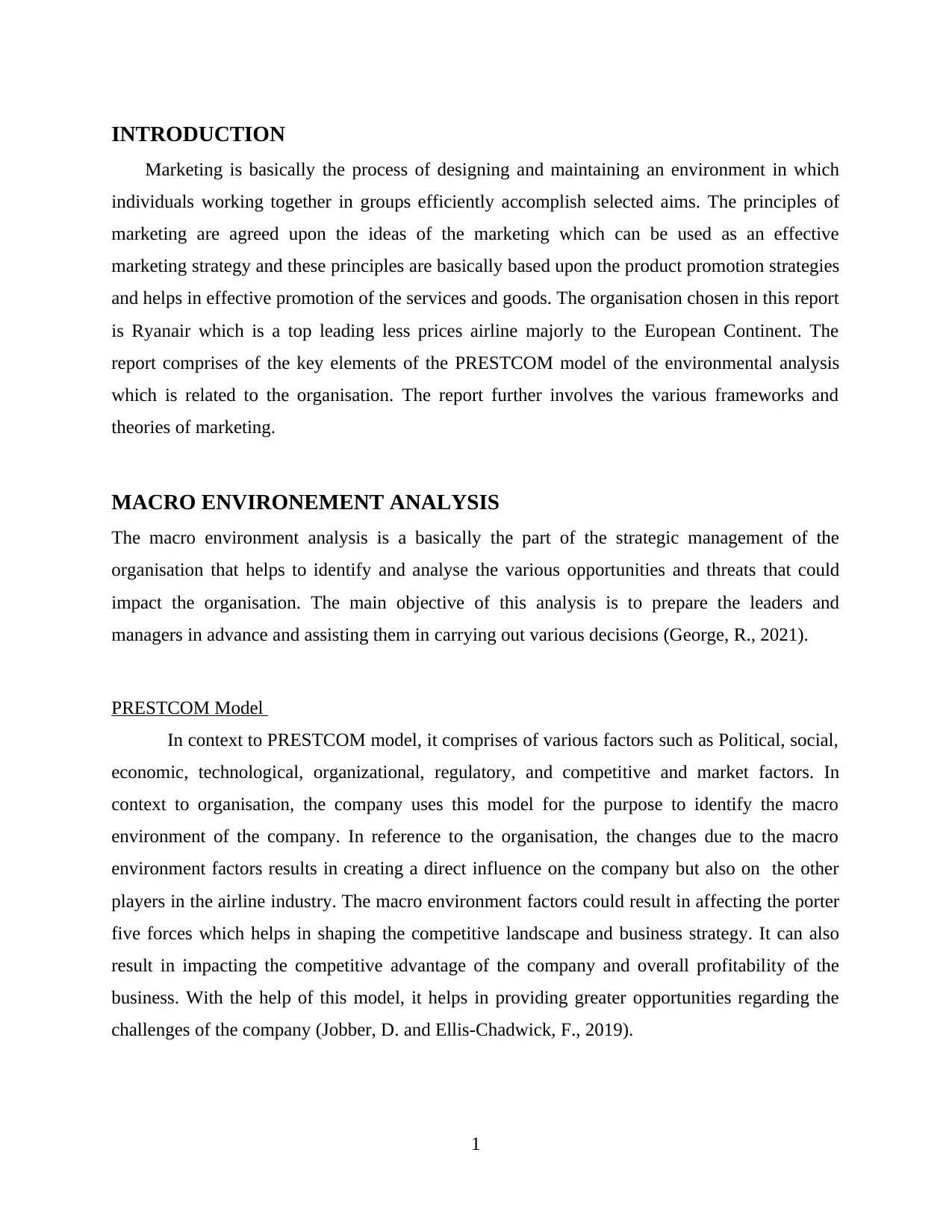
INTRODUCTION
Marketing is basically the process of designing and maintaining an environment in which
individuals working together in groups efficiently accomplish selected aims. The principles of
marketing are agreed upon the ideas of the marketing which can be used as an effective
marketing strategy and these principles are basically based upon the product promotion strategies
and helps in effective promotion of the services and goods. The organisation chosen in this report
is Ryanair which is a top leading less prices airline majorly to the European Continent. The
report comprises of the key elements of the PRESTCOM model of the environmental analysis
which is related to the organisation. The report further involves the various frameworks and
theories of marketing.
MACRO ENVIRONEMENT ANALYSIS
The macro environment analysis is a basically the part of the strategic management of the
organisation that helps to identify and analyse the various opportunities and threats that could
impact the organisation. The main objective of this analysis is to prepare the leaders and
managers in advance and assisting them in carrying out various decisions (George, R., 2021).
PRESTCOM Model
In context to PRESTCOM model, it comprises of various factors such as Political, social,
economic, technological, organizational, regulatory, and competitive and market factors. In
context to organisation, the company uses this model for the purpose to identify the macro
environment of the company. In reference to the organisation, the changes due to the macro
environment factors results in creating a direct influence on the company but also on the other
players in the airline industry. The macro environment factors could result in affecting the porter
five forces which helps in shaping the competitive landscape and business strategy. It can also
result in impacting the competitive advantage of the company and overall profitability of the
business. With the help of this model, it helps in providing greater opportunities regarding the
challenges of the company (Jobber, D. and Ellis-Chadwick, F., 2019).
1
Marketing is basically the process of designing and maintaining an environment in which
individuals working together in groups efficiently accomplish selected aims. The principles of
marketing are agreed upon the ideas of the marketing which can be used as an effective
marketing strategy and these principles are basically based upon the product promotion strategies
and helps in effective promotion of the services and goods. The organisation chosen in this report
is Ryanair which is a top leading less prices airline majorly to the European Continent. The
report comprises of the key elements of the PRESTCOM model of the environmental analysis
which is related to the organisation. The report further involves the various frameworks and
theories of marketing.
MACRO ENVIRONEMENT ANALYSIS
The macro environment analysis is a basically the part of the strategic management of the
organisation that helps to identify and analyse the various opportunities and threats that could
impact the organisation. The main objective of this analysis is to prepare the leaders and
managers in advance and assisting them in carrying out various decisions (George, R., 2021).
PRESTCOM Model
In context to PRESTCOM model, it comprises of various factors such as Political, social,
economic, technological, organizational, regulatory, and competitive and market factors. In
context to organisation, the company uses this model for the purpose to identify the macro
environment of the company. In reference to the organisation, the changes due to the macro
environment factors results in creating a direct influence on the company but also on the other
players in the airline industry. The macro environment factors could result in affecting the porter
five forces which helps in shaping the competitive landscape and business strategy. It can also
result in impacting the competitive advantage of the company and overall profitability of the
business. With the help of this model, it helps in providing greater opportunities regarding the
challenges of the company (Jobber, D. and Ellis-Chadwick, F., 2019).
1
Paraphrase This Document
Need a fresh take? Get an instant paraphrase of this document with our AI Paraphraser
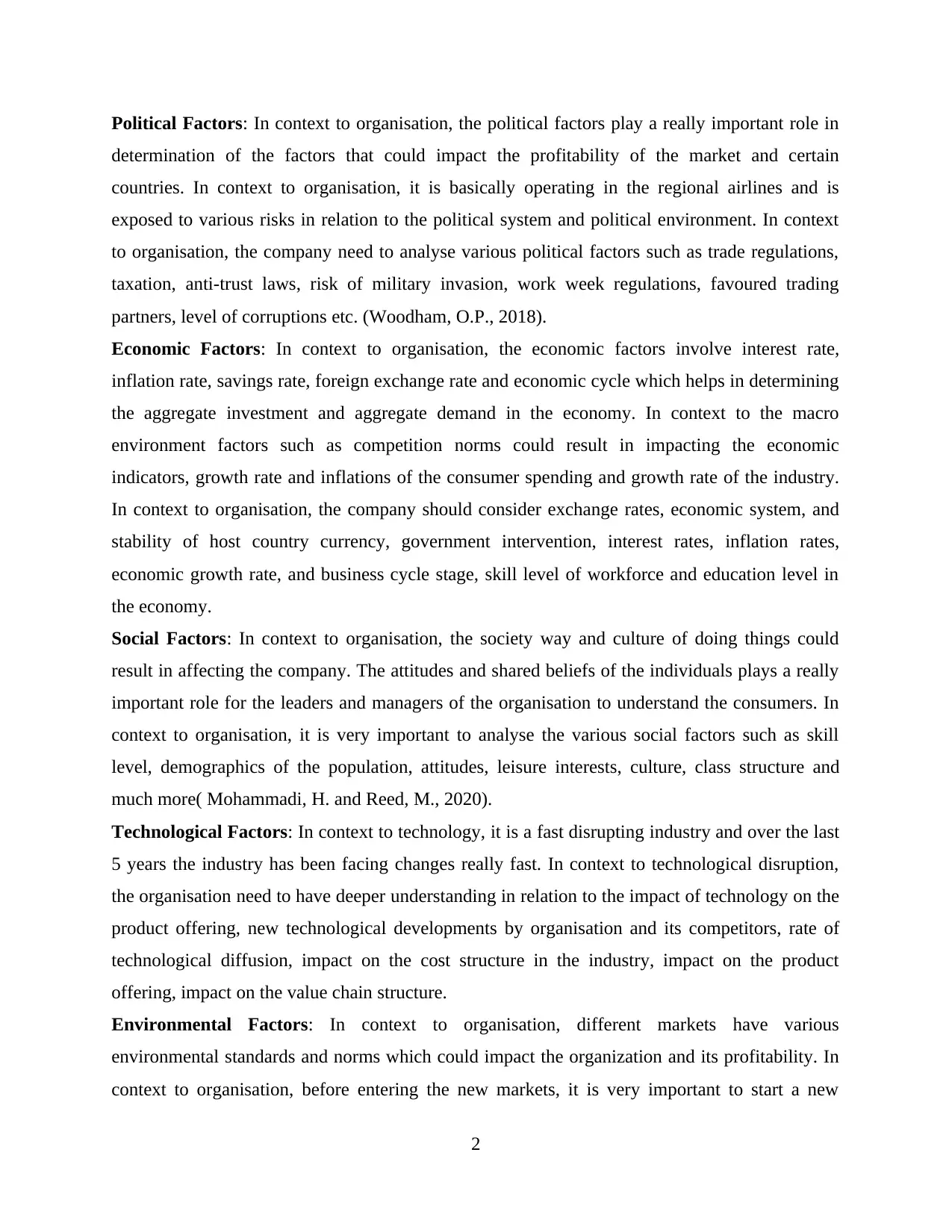
Political Factors: In context to organisation, the political factors play a really important role in
determination of the factors that could impact the profitability of the market and certain
countries. In context to organisation, it is basically operating in the regional airlines and is
exposed to various risks in relation to the political system and political environment. In context
to organisation, the company need to analyse various political factors such as trade regulations,
taxation, anti-trust laws, risk of military invasion, work week regulations, favoured trading
partners, level of corruptions etc. (Woodham, O.P., 2018).
Economic Factors: In context to organisation, the economic factors involve interest rate,
inflation rate, savings rate, foreign exchange rate and economic cycle which helps in determining
the aggregate investment and aggregate demand in the economy. In context to the macro
environment factors such as competition norms could result in impacting the economic
indicators, growth rate and inflations of the consumer spending and growth rate of the industry.
In context to organisation, the company should consider exchange rates, economic system, and
stability of host country currency, government intervention, interest rates, inflation rates,
economic growth rate, and business cycle stage, skill level of workforce and education level in
the economy.
Social Factors: In context to organisation, the society way and culture of doing things could
result in affecting the company. The attitudes and shared beliefs of the individuals plays a really
important role for the leaders and managers of the organisation to understand the consumers. In
context to organisation, it is very important to analyse the various social factors such as skill
level, demographics of the population, attitudes, leisure interests, culture, class structure and
much more( Mohammadi, H. and Reed, M., 2020).
Technological Factors: In context to technology, it is a fast disrupting industry and over the last
5 years the industry has been facing changes really fast. In context to technological disruption,
the organisation need to have deeper understanding in relation to the impact of technology on the
product offering, new technological developments by organisation and its competitors, rate of
technological diffusion, impact on the cost structure in the industry, impact on the product
offering, impact on the value chain structure.
Environmental Factors: In context to organisation, different markets have various
environmental standards and norms which could impact the organization and its profitability. In
context to organisation, before entering the new markets, it is very important to start a new
2
determination of the factors that could impact the profitability of the market and certain
countries. In context to organisation, it is basically operating in the regional airlines and is
exposed to various risks in relation to the political system and political environment. In context
to organisation, the company need to analyse various political factors such as trade regulations,
taxation, anti-trust laws, risk of military invasion, work week regulations, favoured trading
partners, level of corruptions etc. (Woodham, O.P., 2018).
Economic Factors: In context to organisation, the economic factors involve interest rate,
inflation rate, savings rate, foreign exchange rate and economic cycle which helps in determining
the aggregate investment and aggregate demand in the economy. In context to the macro
environment factors such as competition norms could result in impacting the economic
indicators, growth rate and inflations of the consumer spending and growth rate of the industry.
In context to organisation, the company should consider exchange rates, economic system, and
stability of host country currency, government intervention, interest rates, inflation rates,
economic growth rate, and business cycle stage, skill level of workforce and education level in
the economy.
Social Factors: In context to organisation, the society way and culture of doing things could
result in affecting the company. The attitudes and shared beliefs of the individuals plays a really
important role for the leaders and managers of the organisation to understand the consumers. In
context to organisation, it is very important to analyse the various social factors such as skill
level, demographics of the population, attitudes, leisure interests, culture, class structure and
much more( Mohammadi, H. and Reed, M., 2020).
Technological Factors: In context to technology, it is a fast disrupting industry and over the last
5 years the industry has been facing changes really fast. In context to technological disruption,
the organisation need to have deeper understanding in relation to the impact of technology on the
product offering, new technological developments by organisation and its competitors, rate of
technological diffusion, impact on the cost structure in the industry, impact on the product
offering, impact on the value chain structure.
Environmental Factors: In context to organisation, different markets have various
environmental standards and norms which could impact the organization and its profitability. In
context to organisation, before entering the new markets, it is very important to start a new
2
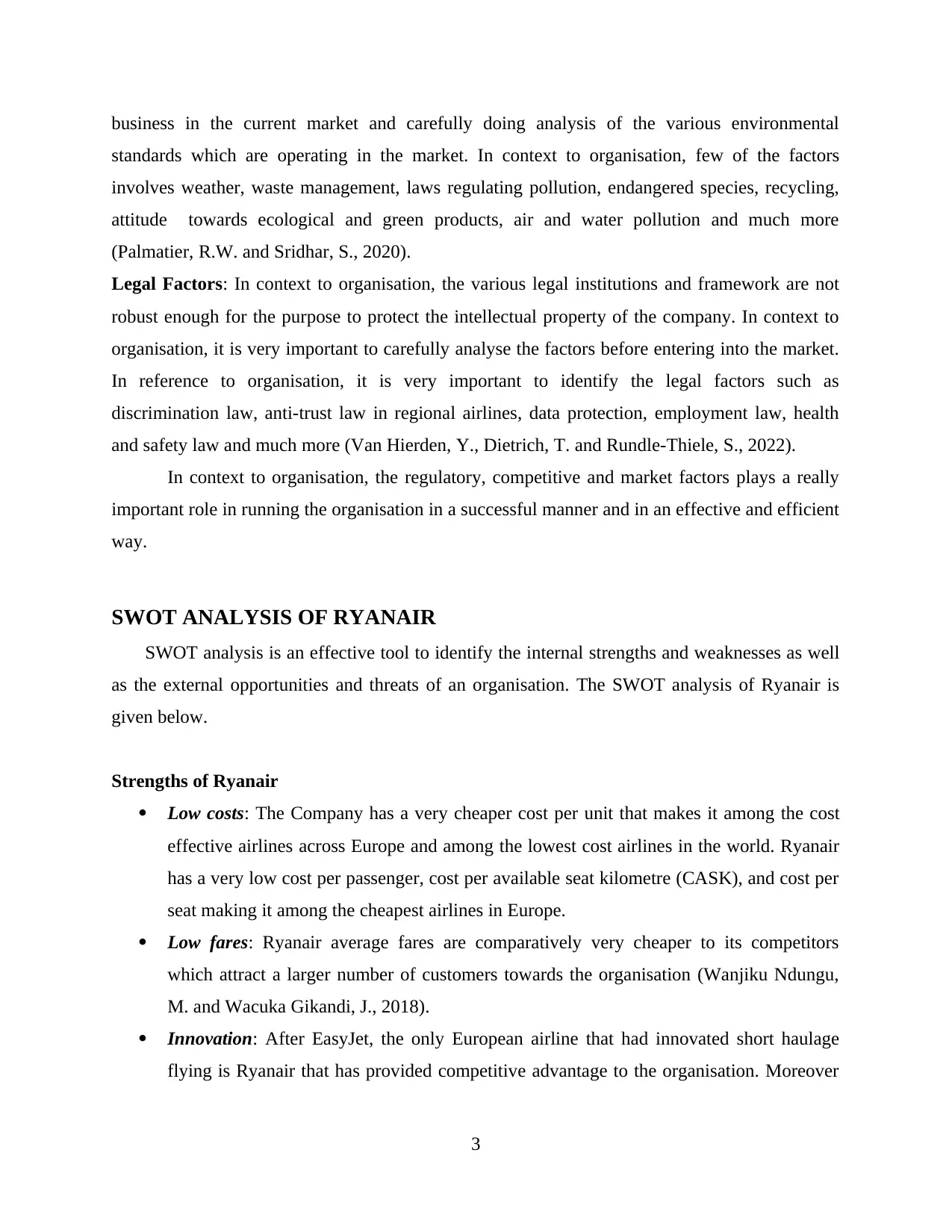
business in the current market and carefully doing analysis of the various environmental
standards which are operating in the market. In context to organisation, few of the factors
involves weather, waste management, laws regulating pollution, endangered species, recycling,
attitude towards ecological and green products, air and water pollution and much more
(Palmatier, R.W. and Sridhar, S., 2020).
Legal Factors: In context to organisation, the various legal institutions and framework are not
robust enough for the purpose to protect the intellectual property of the company. In context to
organisation, it is very important to carefully analyse the factors before entering into the market.
In reference to organisation, it is very important to identify the legal factors such as
discrimination law, anti-trust law in regional airlines, data protection, employment law, health
and safety law and much more (Van Hierden, Y., Dietrich, T. and Rundle-Thiele, S., 2022).
In context to organisation, the regulatory, competitive and market factors plays a really
important role in running the organisation in a successful manner and in an effective and efficient
way.
SWOT ANALYSIS OF RYANAIR
SWOT analysis is an effective tool to identify the internal strengths and weaknesses as well
as the external opportunities and threats of an organisation. The SWOT analysis of Ryanair is
given below.
Strengths of Ryanair
Low costs: The Company has a very cheaper cost per unit that makes it among the cost
effective airlines across Europe and among the lowest cost airlines in the world. Ryanair
has a very low cost per passenger, cost per available seat kilometre (CASK), and cost per
seat making it among the cheapest airlines in Europe.
Low fares: Ryanair average fares are comparatively very cheaper to its competitors
which attract a larger number of customers towards the organisation (Wanjiku Ndungu,
M. and Wacuka Gikandi, J., 2018).
Innovation: After EasyJet, the only European airline that had innovated short haulage
flying is Ryanair that has provided competitive advantage to the organisation. Moreover
3
standards which are operating in the market. In context to organisation, few of the factors
involves weather, waste management, laws regulating pollution, endangered species, recycling,
attitude towards ecological and green products, air and water pollution and much more
(Palmatier, R.W. and Sridhar, S., 2020).
Legal Factors: In context to organisation, the various legal institutions and framework are not
robust enough for the purpose to protect the intellectual property of the company. In context to
organisation, it is very important to carefully analyse the factors before entering into the market.
In reference to organisation, it is very important to identify the legal factors such as
discrimination law, anti-trust law in regional airlines, data protection, employment law, health
and safety law and much more (Van Hierden, Y., Dietrich, T. and Rundle-Thiele, S., 2022).
In context to organisation, the regulatory, competitive and market factors plays a really
important role in running the organisation in a successful manner and in an effective and efficient
way.
SWOT ANALYSIS OF RYANAIR
SWOT analysis is an effective tool to identify the internal strengths and weaknesses as well
as the external opportunities and threats of an organisation. The SWOT analysis of Ryanair is
given below.
Strengths of Ryanair
Low costs: The Company has a very cheaper cost per unit that makes it among the cost
effective airlines across Europe and among the lowest cost airlines in the world. Ryanair
has a very low cost per passenger, cost per available seat kilometre (CASK), and cost per
seat making it among the cheapest airlines in Europe.
Low fares: Ryanair average fares are comparatively very cheaper to its competitors
which attract a larger number of customers towards the organisation (Wanjiku Ndungu,
M. and Wacuka Gikandi, J., 2018).
Innovation: After EasyJet, the only European airline that had innovated short haulage
flying is Ryanair that has provided competitive advantage to the organisation. Moreover
3
You're viewing a preview
Unlock full access by subscribing today!
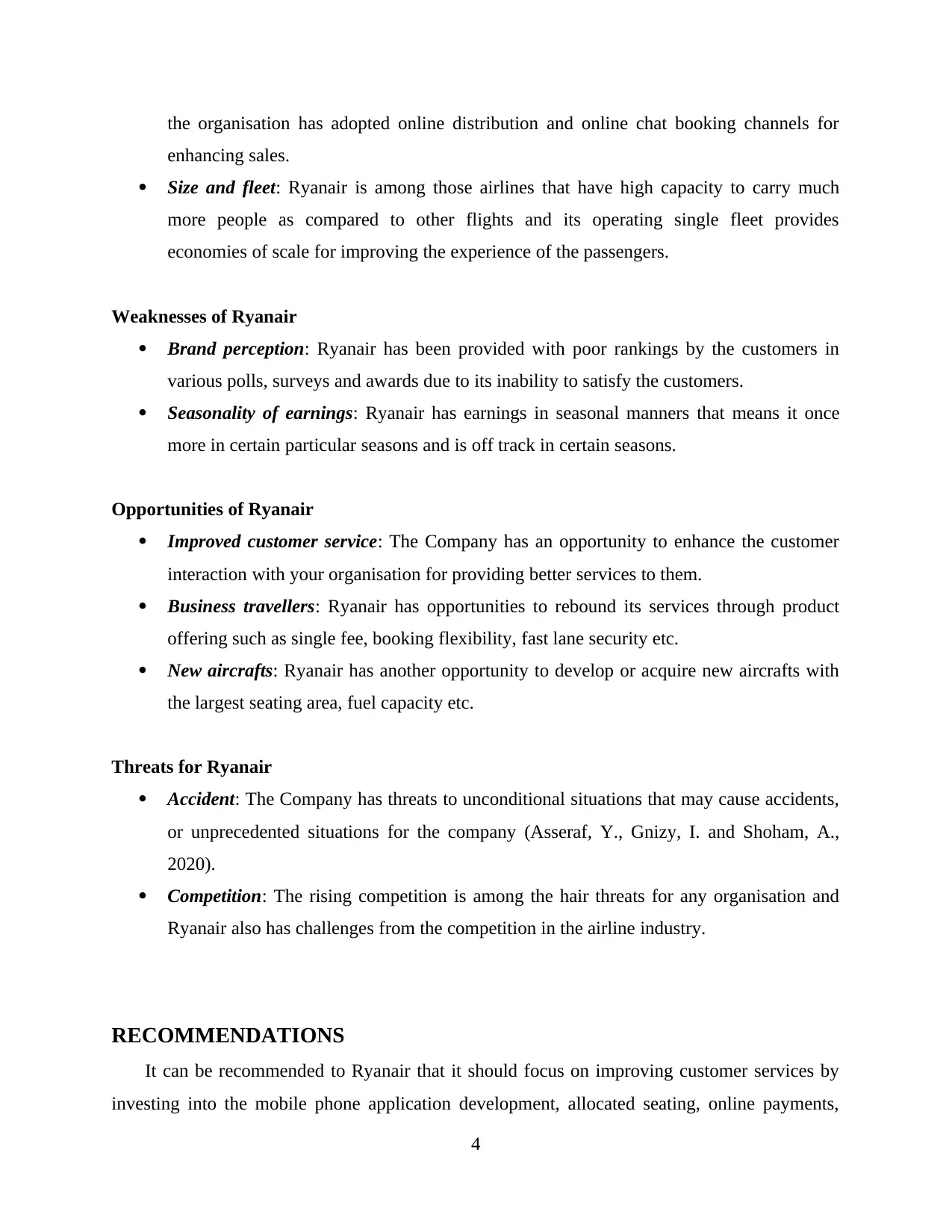
the organisation has adopted online distribution and online chat booking channels for
enhancing sales.
Size and fleet: Ryanair is among those airlines that have high capacity to carry much
more people as compared to other flights and its operating single fleet provides
economies of scale for improving the experience of the passengers.
Weaknesses of Ryanair
Brand perception: Ryanair has been provided with poor rankings by the customers in
various polls, surveys and awards due to its inability to satisfy the customers.
Seasonality of earnings: Ryanair has earnings in seasonal manners that means it once
more in certain particular seasons and is off track in certain seasons.
Opportunities of Ryanair
Improved customer service: The Company has an opportunity to enhance the customer
interaction with your organisation for providing better services to them.
Business travellers: Ryanair has opportunities to rebound its services through product
offering such as single fee, booking flexibility, fast lane security etc.
New aircrafts: Ryanair has another opportunity to develop or acquire new aircrafts with
the largest seating area, fuel capacity etc.
Threats for Ryanair
Accident: The Company has threats to unconditional situations that may cause accidents,
or unprecedented situations for the company (Asseraf, Y., Gnizy, I. and Shoham, A.,
2020).
Competition: The rising competition is among the hair threats for any organisation and
Ryanair also has challenges from the competition in the airline industry.
RECOMMENDATIONS
It can be recommended to Ryanair that it should focus on improving customer services by
investing into the mobile phone application development, allocated seating, online payments,
4
enhancing sales.
Size and fleet: Ryanair is among those airlines that have high capacity to carry much
more people as compared to other flights and its operating single fleet provides
economies of scale for improving the experience of the passengers.
Weaknesses of Ryanair
Brand perception: Ryanair has been provided with poor rankings by the customers in
various polls, surveys and awards due to its inability to satisfy the customers.
Seasonality of earnings: Ryanair has earnings in seasonal manners that means it once
more in certain particular seasons and is off track in certain seasons.
Opportunities of Ryanair
Improved customer service: The Company has an opportunity to enhance the customer
interaction with your organisation for providing better services to them.
Business travellers: Ryanair has opportunities to rebound its services through product
offering such as single fee, booking flexibility, fast lane security etc.
New aircrafts: Ryanair has another opportunity to develop or acquire new aircrafts with
the largest seating area, fuel capacity etc.
Threats for Ryanair
Accident: The Company has threats to unconditional situations that may cause accidents,
or unprecedented situations for the company (Asseraf, Y., Gnizy, I. and Shoham, A.,
2020).
Competition: The rising competition is among the hair threats for any organisation and
Ryanair also has challenges from the competition in the airline industry.
RECOMMENDATIONS
It can be recommended to Ryanair that it should focus on improving customer services by
investing into the mobile phone application development, allocated seating, online payments,
4
Paraphrase This Document
Need a fresh take? Get an instant paraphrase of this document with our AI Paraphraser
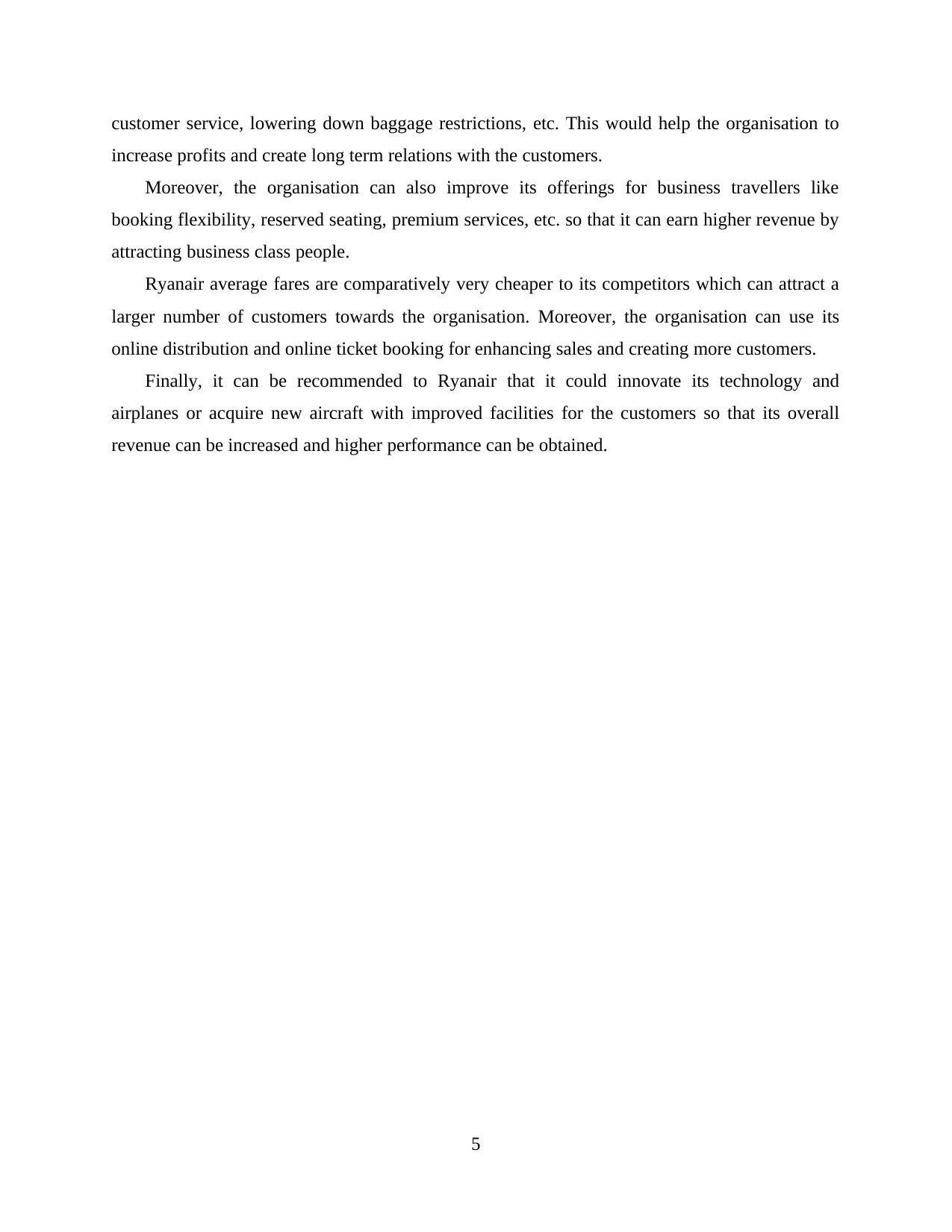
customer service, lowering down baggage restrictions, etc. This would help the organisation to
increase profits and create long term relations with the customers.
Moreover, the organisation can also improve its offerings for business travellers like
booking flexibility, reserved seating, premium services, etc. so that it can earn higher revenue by
attracting business class people.
Ryanair average fares are comparatively very cheaper to its competitors which can attract a
larger number of customers towards the organisation. Moreover, the organisation can use its
online distribution and online ticket booking for enhancing sales and creating more customers.
Finally, it can be recommended to Ryanair that it could innovate its technology and
airplanes or acquire new aircraft with improved facilities for the customers so that its overall
revenue can be increased and higher performance can be obtained.
5
increase profits and create long term relations with the customers.
Moreover, the organisation can also improve its offerings for business travellers like
booking flexibility, reserved seating, premium services, etc. so that it can earn higher revenue by
attracting business class people.
Ryanair average fares are comparatively very cheaper to its competitors which can attract a
larger number of customers towards the organisation. Moreover, the organisation can use its
online distribution and online ticket booking for enhancing sales and creating more customers.
Finally, it can be recommended to Ryanair that it could innovate its technology and
airplanes or acquire new aircraft with improved facilities for the customers so that its overall
revenue can be increased and higher performance can be obtained.
5
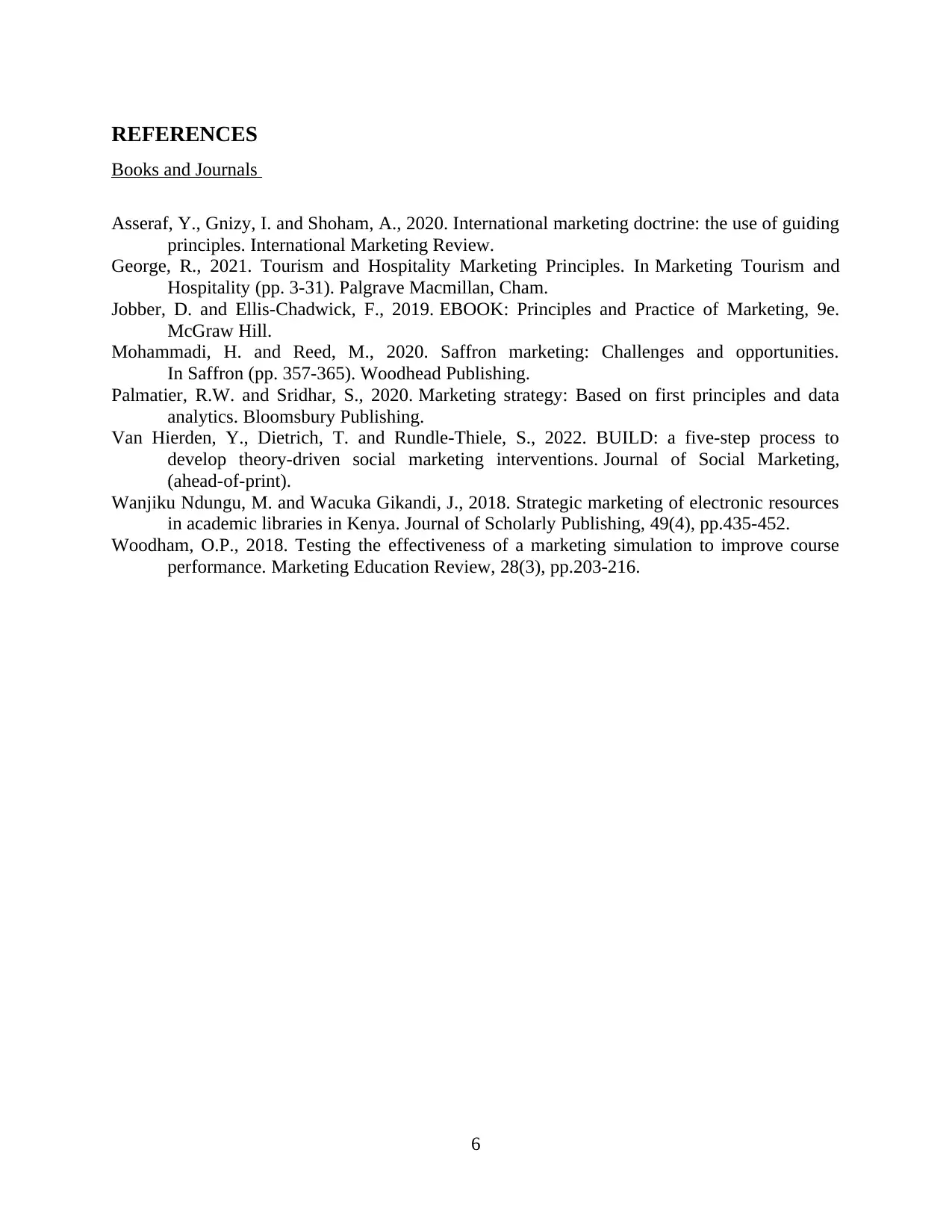
REFERENCES
Books and Journals
Asseraf, Y., Gnizy, I. and Shoham, A., 2020. International marketing doctrine: the use of guiding
principles. International Marketing Review.
George, R., 2021. Tourism and Hospitality Marketing Principles. In Marketing Tourism and
Hospitality (pp. 3-31). Palgrave Macmillan, Cham.
Jobber, D. and Ellis-Chadwick, F., 2019. EBOOK: Principles and Practice of Marketing, 9e.
McGraw Hill.
Mohammadi, H. and Reed, M., 2020. Saffron marketing: Challenges and opportunities.
In Saffron (pp. 357-365). Woodhead Publishing.
Palmatier, R.W. and Sridhar, S., 2020. Marketing strategy: Based on first principles and data
analytics. Bloomsbury Publishing.
Van Hierden, Y., Dietrich, T. and Rundle-Thiele, S., 2022. BUILD: a five-step process to
develop theory-driven social marketing interventions. Journal of Social Marketing,
(ahead-of-print).
Wanjiku Ndungu, M. and Wacuka Gikandi, J., 2018. Strategic marketing of electronic resources
in academic libraries in Kenya. Journal of Scholarly Publishing, 49(4), pp.435-452.
Woodham, O.P., 2018. Testing the effectiveness of a marketing simulation to improve course
performance. Marketing Education Review, 28(3), pp.203-216.
6
Books and Journals
Asseraf, Y., Gnizy, I. and Shoham, A., 2020. International marketing doctrine: the use of guiding
principles. International Marketing Review.
George, R., 2021. Tourism and Hospitality Marketing Principles. In Marketing Tourism and
Hospitality (pp. 3-31). Palgrave Macmillan, Cham.
Jobber, D. and Ellis-Chadwick, F., 2019. EBOOK: Principles and Practice of Marketing, 9e.
McGraw Hill.
Mohammadi, H. and Reed, M., 2020. Saffron marketing: Challenges and opportunities.
In Saffron (pp. 357-365). Woodhead Publishing.
Palmatier, R.W. and Sridhar, S., 2020. Marketing strategy: Based on first principles and data
analytics. Bloomsbury Publishing.
Van Hierden, Y., Dietrich, T. and Rundle-Thiele, S., 2022. BUILD: a five-step process to
develop theory-driven social marketing interventions. Journal of Social Marketing,
(ahead-of-print).
Wanjiku Ndungu, M. and Wacuka Gikandi, J., 2018. Strategic marketing of electronic resources
in academic libraries in Kenya. Journal of Scholarly Publishing, 49(4), pp.435-452.
Woodham, O.P., 2018. Testing the effectiveness of a marketing simulation to improve course
performance. Marketing Education Review, 28(3), pp.203-216.
6
You're viewing a preview
Unlock full access by subscribing today!
1 out of 9
Related Documents
Your All-in-One AI-Powered Toolkit for Academic Success.
+13062052269
info@desklib.com
Available 24*7 on WhatsApp / Email
![[object Object]](/_next/static/media/star-bottom.7253800d.svg)
Unlock your academic potential
© 2024 | Zucol Services PVT LTD | All rights reserved.




